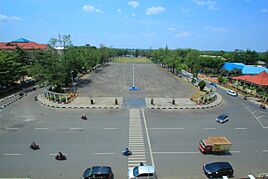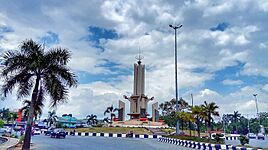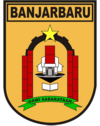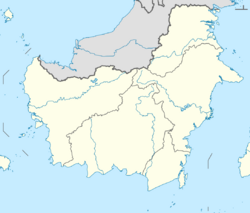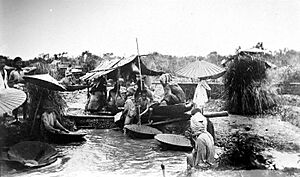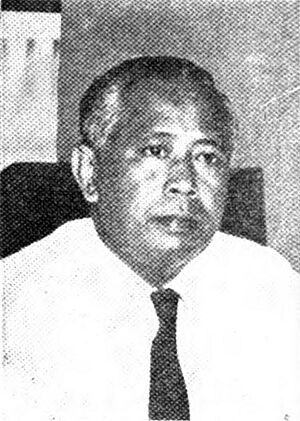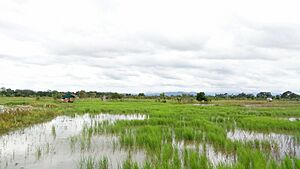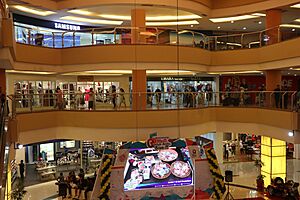Banjarbaru facts for kids
Quick facts for kids
Banjarbaru
|
||
|---|---|---|
|
City
|
||
| City of Banjarbaru Kota Banjarbaru |
||
|
Clockwise, from top: Dr. Murdjani Field, Al Munawarah Grand Mosque, Welcome Monument, Lambung Mangkurat Museum
|
||
|
||
| Nickname(s):
Kota Bukit
(City of Hills) |
||
| Motto(s):
Gawi Sabarataan
|
||
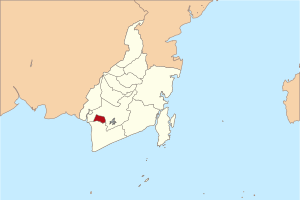
Location within the Province of South Kalimantan
|
||
| Country | ||
| Region | Kalimantan | |
| Province | ||
| Area | ||
| • Total | 305.15 km2 (117.82 sq mi) | |
| Elevation | 23 m (75 ft) | |
| Population
(mid 2023 estimate)
|
||
| • Total | 272,763 | |
| • Density | 893.865/km2 (2,315.10/sq mi) | |
| Time zone | UTC+8 (Indonesia Central Time) | |
| Area code | (+62) 511 | |
| HDI (2023) | ||
Banjarbaru is the capital city of South Kalimantan, a province in Indonesia. It's located about 35 kilometers (22 miles) southeast of Banjarmasin, which is the biggest city in the province.
As of mid-2023, Banjarbaru had about 272,763 people living there. It's the second-largest city in South Kalimantan after Banjarmasin. The nearby town of Martapura is right next to Banjarbaru, almost like an extension of the city.
Contents
History of Banjarbaru
How Banjarbaru Got Its Name
The name Banjarbaru was first used as a temporary name by Governor Dr. Murdjani. He wanted to call it something different from Banjarmasin. In the Indonesian language, "baru" means "new". So, Banjarbaru means "New Banjar". People living there liked the name, and it eventually became the official name of the city. Before it was a city, Banjarbaru was an area with many hills, known as Mount Apam.
Early Days and Diamond Mining
Diamond mines have been active in an area called Cempaka (now part of Banjarbaru) since the 1400s. This was during the time of the Hindu-Buddhist kingdom called Negara Dipa. Later, under the Banjar Sultanate, there was a rule that any diamond weighing four carats or more had to be sold only to the sultan.
The area was mostly empty, except for places where diamond miners from Cempaka would rest. Even during the time when the Dutch ruled Indonesia, diamond mining in Cempaka was regulated by special laws.
Becoming a City and Capital
In the 1950s, Banjarmasin often experienced floods, which made it hard for the government to work. So, people suggested moving the capital of Kalimantan province to a new city. A Dutch architect helped plan Banjarbaru, designing it with many city parks and a city hall in the middle, similar to European cities.
However, the plan to move the entire provincial government never fully happened. As of 2021, only the governor's office for South Kalimantan has moved to Banjarbaru. The provincial parliament is still in Banjarmasin.
There was also a plan for Banjarbaru to become a center for the steel industry in Kalimantan. This plan involved help from the Soviet Union in 1956. But the steel factories were never built.
On April 20, 1999, Banjarbaru officially became its own independent city. Before that, it was part of Banjar Regency. Later, on February 15, 2022, Banjarbaru legally became the capital city of the South Kalimantan province.
Geography of Banjarbaru
Banjarbaru is located at the base of the Meratus Mountains. Most of the city (80%) is fairly low, between 0 and 25 meters (82 feet) above sea level. However, some parts can reach up to 500 meters (1,640 feet) high.
To the north, east, and west, Banjarbaru shares borders with Banjar Regency. To the south, it borders Tanah Laut Regency. The soil in most of the city is called Podzol, but in the Landasan Ulin area, the soil is mostly peat and alluvium.
Banjarbaru is one of the smaller administrative areas in the province. It covers about 0.88% of South Kalimantan's total land.
Climate in Banjarbaru
Banjarbaru has a tropical savanna climate. This means it's warm all year round because it's close to the equator. It gets a lot of rain, especially from November to May, but June to October are a bit drier. The city receives about 2,627 millimeters (103 inches) of rain each year.
The average temperature is around 27.2°C (81°F). The highest temperature ever recorded in Banjarbaru was 40.6°C (105.1°F) on August 16, 1997. This is the highest temperature ever recorded in Indonesia.
| Climate data for Banjarbaru (1991–2020 normals) | |||||||||||||
|---|---|---|---|---|---|---|---|---|---|---|---|---|---|
| Month | Jan | Feb | Mar | Apr | May | Jun | Jul | Aug | Sep | Oct | Nov | Dec | Year |
| Record high °C (°F) | 34.6 (94.3) |
34.5 (94.1) |
35.1 (95.2) |
35.9 (96.6) |
34.6 (94.3) |
35.6 (96.1) |
34.5 (94.1) |
36.5 (97.7) |
35.6 (96.1) |
36.4 (97.5) |
35.7 (96.3) |
35.0 (95.0) |
36.5 (97.7) |
| Mean daily maximum °C (°F) | 31.5 (88.7) |
31.8 (89.2) |
32.0 (89.6) |
32.3 (90.1) |
32.5 (90.5) |
32.2 (90.0) |
32.1 (89.8) |
32.7 (90.9) |
33.2 (91.8) |
33.2 (91.8) |
32.4 (90.3) |
31.6 (88.9) |
32.3 (90.1) |
| Daily mean °C (°F) | 27.5 (81.5) |
27.6 (81.7) |
27.7 (81.9) |
27.9 (82.2) |
28.1 (82.6) |
27.6 (81.7) |
27.3 (81.1) |
27.4 (81.3) |
27.8 (82.0) |
28.1 (82.6) |
27.9 (82.2) |
27.6 (81.7) |
27.7 (81.9) |
| Mean daily minimum °C (°F) | 23.3 (73.9) |
23.4 (74.1) |
23.4 (74.1) |
23.6 (74.5) |
23.6 (74.5) |
23.0 (73.4) |
22.2 (72.0) |
21.8 (71.2) |
22.2 (72.0) |
22.9 (73.2) |
23.5 (74.3) |
23.4 (74.1) |
23.0 (73.4) |
| Record low °C (°F) | 19.5 (67.1) |
19.9 (67.8) |
17.5 (63.5) |
20.6 (69.1) |
18.9 (66.0) |
18.0 (64.4) |
16.8 (62.2) |
17.8 (64.0) |
16.0 (60.8) |
17.6 (63.7) |
19.7 (67.5) |
20.9 (69.6) |
16.0 (60.8) |
| Average precipitation mm (inches) | 377.8 (14.87) |
296.0 (11.65) |
309.0 (12.17) |
273.4 (10.76) |
187.9 (7.40) |
157.0 (6.18) |
101.2 (3.98) |
66.6 (2.62) |
82.1 (3.23) |
142.7 (5.62) |
250.1 (9.85) |
395.0 (15.55) |
2,638.8 (103.89) |
| Average precipitation days (≥ 1.0 mm) | 21.5 | 17.8 | 18.4 | 17.3 | 14.7 | 13.2 | 11.1 | 8.7 | 7.7 | 12.4 | 16.9 | 22.1 | 181.8 |
| Mean monthly sunshine hours | 101.9 | 92.0 | 122.4 | 137.2 | 154.8 | 140.4 | 158.8 | 176.3 | 160.1 | 150.3 | 124.1 | 99.4 | 1,617.7 |
| Source: World Meteorological Organization | |||||||||||||
People of Banjarbaru
Most people in Banjarbaru are Muslim, making up about 94% of the population. There are also Christians, Hindus, and Buddhists living in the city.
As of mid-2023, there were slightly more males than females. The South Banjarbaru district is the most crowded, while Cempaka is the least crowded.
Many people in Banjarbaru are young adults, aged between 20 and 39. About 70% of the city's population in 2019 was between 15 and 64 years old. The average life expectancy in the city is about 71.87 years, which is higher than the average for the whole province.
Economy of Banjarbaru
In 2019, Banjarbaru's economy grew by 7%, which is a good rate. The service sector, like shops and offices, is the biggest part of the city's economy. Other important parts include restaurants, hotels, and construction.
The Cempaka district is unique because its economy still relies on mining (mostly diamonds) and agriculture. Diamond mining in Cempaka has been around for a long time. However, it's hard for the city to collect taxes from this industry because many diamond deals happen secretly. Also, fewer people are investing in mining.
The agriculture sector is also getting smaller in Banjarbaru. There aren't many rice fields left. Young people in the city are often more interested in other jobs than mining or farming. The unemployment rate in Banjarbaru was 5.06% in 2019.
How Banjarbaru is Governed
City Districts
Banjarbaru is divided into five main areas called districts (kecamatan). These are North Banjarbaru, South Banjarbaru, Cempaka, Landasan Ulin, and Liang Anggang. Each district is further divided into four smaller areas called urban villages (kelurahan).
Here's a table showing the districts and their populations:
| Kode Wilayah |
Name of District (kecamatan) |
Area in km2 |
Pop'n Census 2010 |
Pop'n Census 2020 |
Pop'n Estimate mid 2023 |
Admin centre |
No. of kelurahan |
Post codes |
|---|---|---|---|---|---|---|---|---|
| 63.72.02 | Landasan Ulin | 74.03 | 51,510 | 75,385 | 81,000 | Landasan Ulin Timur | 4 | 70724 (a) |
| 63.72.06 | Liang Anggang | 74.74 | 34,548 | 44,358 | 48,859 | Landasan Ulin Barat | 4 | 70724 (b) |
| 63.72.03 | Cempaka | 114.53 | 28,319 | 35,584 | 37,590 | Sungai Tiung | 4 | 70731 - 70734 |
| 63.72.04 | Banjarbaru Utara | 26.84 | 42,805 | 52,842 | 57,128 | Komet | 4 | 70714 |
| 63.72.05 | Banjarbaru Selatan | 15.01 | 42,445 | 45,273 | 48,186 | Loktabat Selatan | 4 | 70714 (c) |
| Totals | 305.15 | 199,627 | 253,442 | 272,783 | 20 |
Notes: (a) except Guntung Payung kelurahan, with a postcode of 70721. (b) except Landasan Ulin Barat kelurahan, with a postcode of 70722, and Landasan Ulin Tengah kelurahan, with a postcode of 70723. (c) except Guntung Palkat kelurahan, with a postcode of 70713.
Fun Things to Do in Banjarbaru
Banjarbaru has one main shopping mall called QMall. It's connected to a hotel, the Grand Dafam Q Hotel.
There are several fun places to visit in the city, like Amanah Borneo Park, Banua Labyrinth Park, Aquatica Waterpark, and QMall Waterboom. The city also has a public swimming pool called Idaman Public Swimming Pool. If you like nature, the Mentaos Pine Forest is a popular spot.
"Kampung Pelangi," which means "rainbow village," is a popular place to visit. It's located by the Kemuning river. This area used to be a less developed neighborhood, but it has been improved with colorful houses, parks, walking paths, and Wi-Fi spots.
The city also has one museum, the Lambung Mangkurat Museum. It displays historical items from the time of the Banjar Sultanate and the Indonesian National Revolution.
Education in Banjarbaru
Banjarbaru has many schools for different age groups. There are 164 kindergartens, 83 elementary schools, 37 junior high schools, 23 senior high schools, and 16 vocational high schools.
For higher education, there are 14 colleges and universities. The most well-known is Lambung Mangkurat University, which is the only public university in the city. The other higher education institutions are private.
Famous Places in Banjarbaru
Dr. Murdjani Field is a central spot in the city, named after a former governor. It's located across from the city hall and a city park. There are also many convenience stores like Alfamart and Indomaret around the city.
The Haji Idak Stadium used to be in Banjarbaru, but it was taken down to make way for a new market. A bigger sports complex called "New Stadium of Banjarbaru" is planned for the Landasan Ulin district. The Komet Windpump, built in 1972 and fixed up in 2021, even gave its name to the nearby Komet area.
Places to Worship
Banjarbaru has many places of worship. There are about 20 churches, a Balinese temple in the Landasan Ulin district, and over 50 mosques. The largest mosque in the city is the Al Munawarah Grand Mosque in South Banjarbaru, which opened in 2010.
Getting Around Banjarbaru
The city has two bus rapid transit systems, BRT Banjarbakula and Trans Banjarbakula. These buses also connect Banjarbaru to nearby towns and cities. You can also find shared taxis called angkots, and online motorcycle taxi services like Gojek and Grab. Regular taxis are also available.
Syamsudin Noor International Airport is located in the Landasan Ulin district of Banjarbaru. The city has over 645 kilometers (401 miles) of roads, with most of them paved. Banjarbaru is connected to the Trans-Kalimantan Highway Southern Route, which links it to other cities like Banjarmasin and to the provinces of East Kalimantan and Central Kalimantan. A toll road connecting Banjarbaru to Batulicin is currently being built.
As of 2021, there are plans for a special train line to the airport, which would also connect to Banjarmasin. The government is also planning a new development area called "Aero City" near the airport to help the region grow even more.
Media in Banjarbaru
In Banjarbaru, there are several media companies. These include online news sites, a printed newspaper called Radar Banjarmasin, and a television station. There are also two known radio stations, Nirwana FM Banjarbaru and Abdi Persada FM.
The city government also has its own public television and radio broadcasters. These are used to share information with the people of Banjarbaru and are not for commercial purposes.


